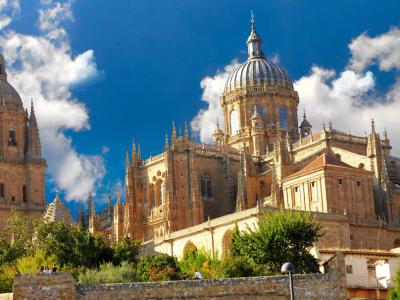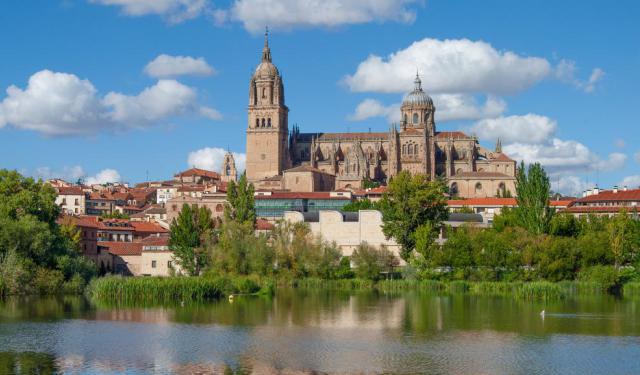
Catedral Nueva de Salamanca (New Cathedral of Salmanca), Salamanca (must see)
In 1509 Ferdinand II of Aragon perceived the Old Cathedral of Salamanca to be "small, dark, and low." He ordered architects Anton Egas and Alonso Rodriguez to drop everything in Toledo and Seville and proceed to Salamanca to lay out a new temple.
The New Cathedral, after much discussion, was to be laid out parallel to the Old Cathedral. It was built in the Gothic style with frank stone from Villamayor. It has a rectangular floor plan with three central naves and two extra naves with niched side chapels. The header end is rectangular, forming a hall plan.
Work was halted through most of the 17th century and completed in 1733. All this suffered some devastation from the Lisbon earthquake of 1755. Afterward, the dome was done over, and the bell tower was strengthened.
The catastrophe is remembered today with a traditional popular ceremony called, "Mariquelo." When the earthquake of 1755 made itself felt in Salamanca, the people huddled in the Cathedral, seeking Heaven's protection. The Cathedral stood, and no one died. The Cathedral Council felt there was a divine pattern to it all.
The Council ordered that each year on October 31st, a Mariquelo family member should climb to the top of the Cathedral to ring the bells in gratitude to God and also, to check on the inclination of the tower, which had developed a slight list. The Mariquelos had been living in the Cathedral, so they got the job.
In 1976 the last member of the clan made the ascent of the tower, and the tradition fell into disuse. In 1985 however, it was revived. Today, a man dressed as a cowboy (charro) climbs the tower, carrying bagpipes and drums. The bell rings, and the people in the square thank God and pray for peace.
The New Cathedral, after much discussion, was to be laid out parallel to the Old Cathedral. It was built in the Gothic style with frank stone from Villamayor. It has a rectangular floor plan with three central naves and two extra naves with niched side chapels. The header end is rectangular, forming a hall plan.
Work was halted through most of the 17th century and completed in 1733. All this suffered some devastation from the Lisbon earthquake of 1755. Afterward, the dome was done over, and the bell tower was strengthened.
The catastrophe is remembered today with a traditional popular ceremony called, "Mariquelo." When the earthquake of 1755 made itself felt in Salamanca, the people huddled in the Cathedral, seeking Heaven's protection. The Cathedral stood, and no one died. The Cathedral Council felt there was a divine pattern to it all.
The Council ordered that each year on October 31st, a Mariquelo family member should climb to the top of the Cathedral to ring the bells in gratitude to God and also, to check on the inclination of the tower, which had developed a slight list. The Mariquelos had been living in the Cathedral, so they got the job.
In 1976 the last member of the clan made the ascent of the tower, and the tradition fell into disuse. In 1985 however, it was revived. Today, a man dressed as a cowboy (charro) climbs the tower, carrying bagpipes and drums. The bell rings, and the people in the square thank God and pray for peace.
Want to visit this sight? Check out these Self-Guided Walking Tours in Salamanca. Alternatively, you can download the mobile app "GPSmyCity: Walks in 1K+ Cities" from Apple App Store or Google Play Store. The app turns your mobile device to a personal tour guide and it works offline, so no data plan is needed when traveling abroad.
Catedral Nueva de Salamanca (New Cathedral of Salmanca) on Map
Sight Name: Catedral Nueva de Salamanca (New Cathedral of Salmanca)
Sight Location: Salamanca, Spain (See walking tours in Salamanca)
Sight Type: Religious
Guide(s) Containing This Sight:
Sight Location: Salamanca, Spain (See walking tours in Salamanca)
Sight Type: Religious
Guide(s) Containing This Sight:
Walking Tours in Salamanca, Spain
Create Your Own Walk in Salamanca
Creating your own self-guided walk in Salamanca is easy and fun. Choose the city attractions that you want to see and a walk route map will be created just for you. You can even set your hotel as the start point of the walk.
Salamanca Introduction Walking Tour
Polybius, the ancient Greek historian, called it "Helmantike." Another ancient Greek historian, Plutarch, opted for "Salmatike." The word "Salamanca" itself refers to a "cave," "grotto," or "dark place." Legend says Satan taught Black Magic in the Caves of Salamanca.
Salamanca's splendor began with the royal charter of Alfonso IX... view more
Tour Duration: 1 Hour(s)
Travel Distance: 1.6 Km or 1 Miles
Salamanca's splendor began with the royal charter of Alfonso IX... view more
Tour Duration: 1 Hour(s)
Travel Distance: 1.6 Km or 1 Miles
Salamanca's Historical Buildings Walking Tour
Salamanca – one of Spain’s most delightful and intriguing destinations – is a treasure trove of architectural marvels. The abundance of well-preserved, centuries-old wonders of construction tucked away in the labyrinth of narrow lanes in this prestigious university city is truly awe-inspiring. A true feast for the eyes, they are so impressive that the entire historic center of Salamanca was... view more
Tour Duration: 2 Hour(s)
Travel Distance: 2.3 Km or 1.4 Miles
Tour Duration: 2 Hour(s)
Travel Distance: 2.3 Km or 1.4 Miles


